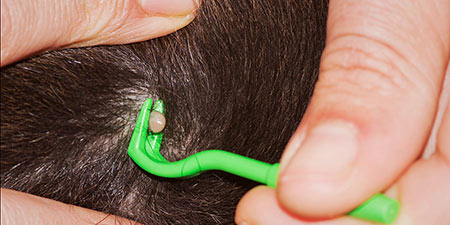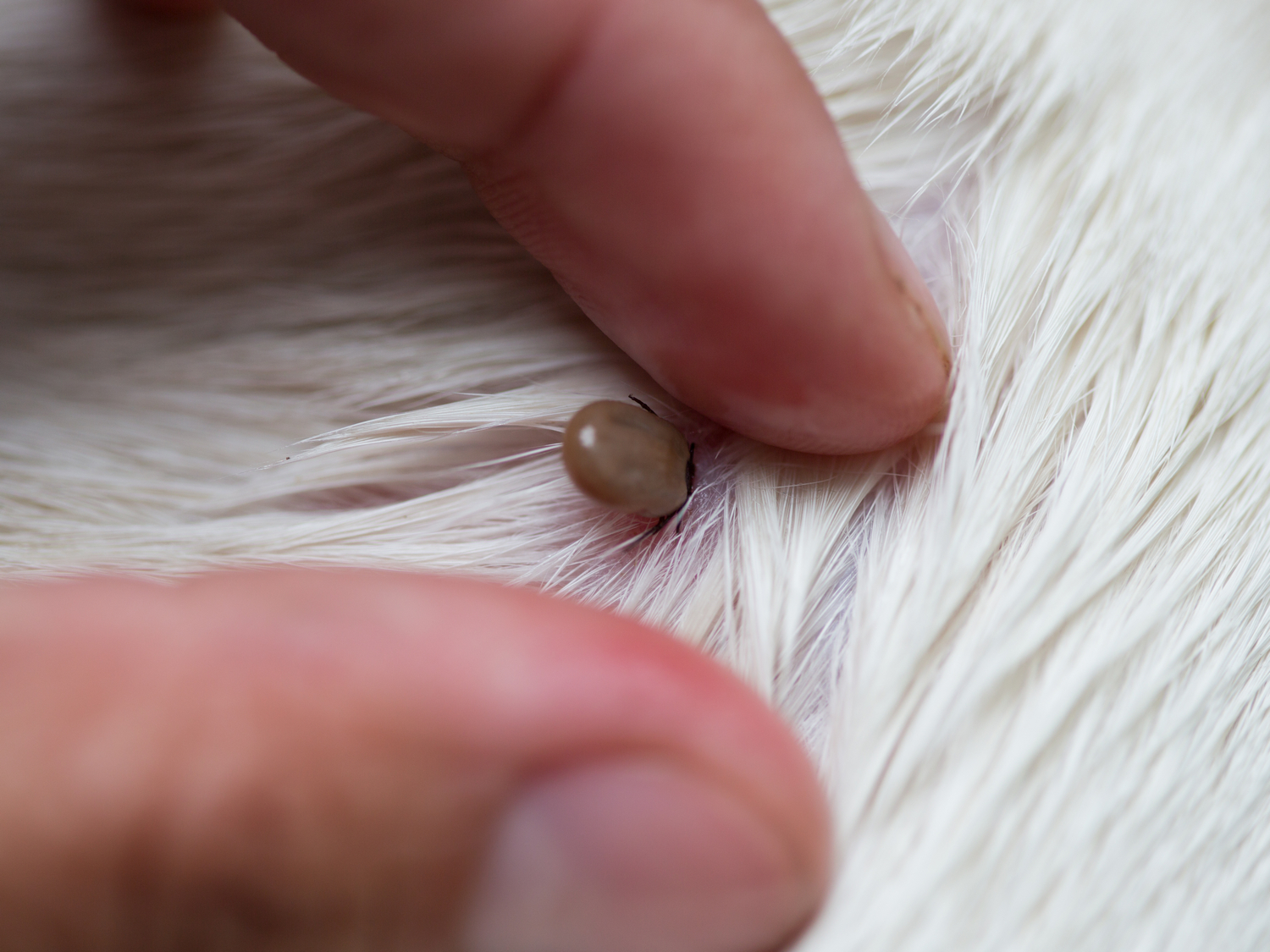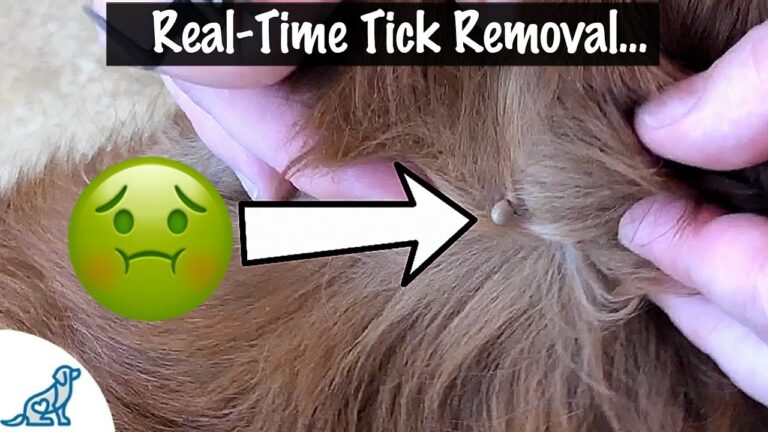To safely remove a tick from a dog, grasp the tick with tweezers and pull it straight out. Avoid twisting or jerking to prevent leaving the mouthparts behind, and clean the area with rubbing alcohol.
Ticks can pose health risks to dogs and should be removed carefully and promptly. It’s crucial to use the proper technique and tools to minimize any potential harm or infection. We will discuss the steps to safely remove ticks from dogs and provide essential tips for preventing tick infestations.
By following these guidelines, you can ensure your dog’s well-being and reduce the risk of tick-related illnesses. Proper tick removal is an essential skill for every dog owner, so let’s dive into the details of this crucial task.

Credit: www.akc.org
Recognizing The Importance Of Tick Removal
When it comes to our four-legged friends, keeping them healthy and happy is our top priority. One threat that can put their well-being at risk is ticks. Recognizing the importance of tick removal is crucial to protect your furry companion from potential harm. Ticks are small, blood-sucking parasites that can transmit various diseases to both animals and humans. Taking prompt action to remove ticks can prevent serious health complications and ensure the safety of your dog.
Signs Of Tick Infestation
Besides itching and discomfort, there are several signs that can indicate a tick infestation on your dog:
- Visible ticks on your dog’s skin or fur.
- Small, red bumps or irritations where the tick has attached.
- Excessive scratching or licking in a particular area.
- Unexplained hair loss or scaly patches on the skin.
- Changes in behavior, such as increased irritability or lethargy.
- Presence of tick eggs or larvae on your dog’s bedding.
If you notice any of these signs, it is essential to act promptly to remove the ticks and prevent further infestation.
The Dangers Of Ticks
Ticks pose significant risks to your dog’s health due to the diseases they carry. Some of the common tick-borne illnesses include:
| Disease | Symptoms |
|---|---|
| Lyme Disease | Fever, joint swelling, lameness |
| Anaplasmosis | Fever, loss of appetite, lethargy |
| Ehrlichiosis | Fever, vomiting, nosebleeds |
| Babesiosis | Fever, anemia, weakness |
These diseases can have severe consequences for your dog’s health, leading to chronic conditions or even fatal outcomes if left untreated. Prompt tick removal is crucial to minimize the risk of your dog contracting these illnesses and experiencing long-term health complications.
Now that you understand the importance of tick removal and the dangers ticks pose to your dog’s well-being, it is essential to learn how to safely remove them to ensure your furry friend stays healthy and happy.

Credit: www.wikihow.com
Preparing For Tick Removal
Before beginning the tick removal process, it’s essential to prepare yourself and your dog to ensure a safe and effective removal. This includes gathering the necessary tools and choosing a safe location for the procedure. By following these steps, you can minimize the risk of complications and make the process smoother for both you and your pup.
Gathering The Necessary Tools
Having the right tools on hand is crucial for a successful tick removal. Here’s a checklist of items to have ready:
- Tick Removal Tool: Ensure you have a proper tick removal tool, such as fine-tipped tweezers or a tick removal hook, to facilitate safe extraction.
- Gloves: Wear gloves to protect yourself from potential exposure to tick-borne diseases and to maintain sanitation.
- Antiseptic Wipes: Have antiseptic wipes or rubbing alcohol available to disinfect the area after the tick is removed.
Choosing A Safe Location
When selecting a location for the tick removal process, consider the comfort and safety of your dog. Opt for a quiet, well-lit area where your dog feels relaxed and secure. You may also want to place a non-slip mat on the surface to prevent your dog from sliding or moving during the procedure. Additionally, it’s important to choose a spot with easy access to the area where the tick is located, such as the head, neck, or ears.
Safe And Effective Tick Removal Techniques
When it comes to the safety and well-being of your furry friend, knowing how to safely remove a tick from your dog is crucial. Tick removal is an important skill that every pet owner should have, as ticks can transmit diseases such as Lyme disease and Rocky Mountain spotted fever. In this article, we will discuss safe and effective tick removal techniques to ensure your dog stays healthy and happy.
Using Fine-tipped Tweezers
When removing a tick from your dog, the proper tools are essential. Use fine-tipped tweezers to grasp the tick as close to the skin as possible. This will help ensure that the entire tick is removed, reducing the risk of leaving behind any parts that could cause an infection.
Grasping The Tick Properly
It’s important to grasp the tick properly to avoid squeezing its body. Squeezing can cause the tick to release more saliva and increase the risk of disease transmission. Gently grasp the tick with the tweezers, ensuring you have a firm hold without crushing it.
Slow And Gentle Removal
Slow and gentle removal is key to reducing the risk of leaving any parts of the tick behind. Avoid twisting or jerking the tick, as this can cause the mouthparts to break off and remain embedded in the skin. Instead, pull the tick straight out with a steady, even pressure.
Avoiding Common Mistakes
When removing a tick, it’s important to avoid common mistakes that could increase the risk of infection. Do not use folk remedies such as matches or petroleum jelly, as these can actually increase the risk of disease transmission. After removing the tick, clean the area with antiseptic to reduce the risk of infection.
Post-removal Care
Once you have successfully removed a tick from your dog, it’s important to provide post-removal care to ensure their health and prevent any complications. This step is crucial as it helps in disinfecting the bite area and monitoring for signs of infection. Here are the two main aspects of post-removal care that you need to focus on:
Disinfecting The Bite Area
After removing the tick, it’s vital to clean and disinfect the bite area to reduce the risk of infection. Follow these steps to effectively disinfect the bite area:
- Gently clean the wound: Use mild soap and warm water to clean the area around the bite. Ensure that the soap is not irritating to your dog’s skin.
- Apply an antiseptic solution: After cleaning, apply a pet-safe antiseptic solution directly to the bite area. This will help kill any remaining bacteria and reduce the chances of infection.
- Keep the area clean and dry: Ensure that the bite area remains clean and dry throughout the healing process. Avoid using harsh chemicals or ointments that may irritate the skin further.
Monitoring For Signs Of Infection
Even with proper removal and disinfection, there is still a risk of infection. It’s crucial to monitor your dog for any signs of infection in the days following the tick removal. Watch out for the following symptoms:
- Redness and swelling: If the area around the bite becomes red, swollen, or increasingly painful, it could be a sign of infection.
- Increased heat: A warm sensation or increased temperature in the area may indicate an infection.
- Pus or discharge: If you notice any discharge or pus coming from the bite wound, it’s a clear sign of infection.
- Lethargy and loss of appetite: If your dog appears unusually tired, lacks energy, or shows no interest in food, it could be a symptom of infection.
If you observe any of these signs, it’s essential to consult your veterinarian for further evaluation and treatment. Early detection and prompt intervention can prevent the infection from worsening and ensure a swift recovery for your beloved furry friend.
Preventing Future Tick Infestations
Prevent future tick infestations by safely removing ticks from your dog. Follow these simple steps to keep your furry friend tick-free and healthy.
Regular Tick Checks
Regular tick checks are a crucial part of preventing future tick infestations in your dog. After your dog has been outside in areas where ticks are commonly found, take the time to thoroughly inspect their body for any signs of ticks. Start by running your hands over their fur, feeling for any bumps or lumps. Pay close attention to areas such as the ears, between the toes, and under the collar, as ticks are known to hide in these warm and cozy spots. If you find a tick, make sure to remove it promptly and follow the proper steps to ensure your dog’s safety.Using Tick Preventatives
In addition to regular tick checks, using tick preventatives can significantly reduce the risk of future tick infestations. These preventatives come in different forms, such as spot-on treatments, oral medications, and tick collars. While each option has its advantages, it’s important to consult with your veterinarian to determine the right product for your furry friend. These preventatives work by repelling and killing ticks, ensuring that they don’t become a problem for your dog. Remember to consistently apply or administer the tick preventative according to the recommended instructions to keep your dog protected.Maintaining A Tick-free Environment
Another effective way to prevent future tick infestations is to maintain a tick-free environment. Ticks typically thrive in areas with tall grass, shrubs, and leaf litter. To reduce the risk of ticks in your yard, keep the grass trimmed short and remove any overgrown vegetation. Regularly raking up leaves and clearing away debris can also help eliminate tick hiding spots. If possible, create a barrier between wooded areas and your yard, such as a gravel or mulch path, to minimize tick migration. Additionally, consider using tick control products in your outdoor spaces to further protect your dog.In Summary
By incorporating regular tick checks, using tick preventatives, and maintaining a tick-free environment, you can take proactive steps to prevent future tick infestations in your dog. These preventive measures are essential for the health and well-being of your furry friend, reducing the risk of tick-borne illnesses and ensuring they enjoy a tick-free life. Stay vigilant, consult with your veterinarian, and prioritize your dog’s safety when it comes to tick prevention.
Credit: www.vets-now.com
Frequently Asked Questions Of How To Safely Remove A Tick From A Dog
What Are The Risks Of Not Removing A Tick From A Dog?
Not removing a tick from a dog can lead to potential health risks, such as tick-borne diseases like Lyme disease, Anaplasmosis, and Babesiosis. Ticks can also cause skin infections and create discomfort for your dog.
How Do You Safely Remove A Tick From A Dog?
To safely remove a tick from a dog, use fine-tipped tweezers to grasp the tick’s head as close to the skin as possible. Gently pull upward with steady pressure, making sure to remove the whole tick. Clean the area with antiseptic and monitor your dog for any signs of infection or illness.
Can You Use Home Remedies To Remove A Tick From A Dog?
While home remedies like Vaseline, nail polish, or burning the tick may seem convenient, they can actually do more harm than good. These methods can cause the tick to burrow deeper or regurgitate potentially infectious fluids, increasing the risk of disease transmission.
It is best to use proper tick removal techniques.
Conclusion
Removing ticks from your dog is essential for their well-being, but it requires caution and proper technique. By following the steps outlined in this blog post, such as using fine-tipped tweezers and gently pulling the tick straight out, you can safely and effectively remove ticks from your furry friend.
Remember to clean the area and monitor your dog for any signs of illness. Keeping your pet tick-free not only protects their health but also contributes to their overall happiness.



